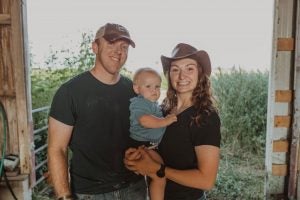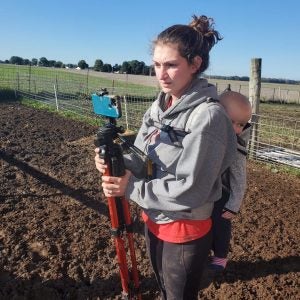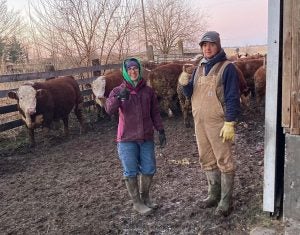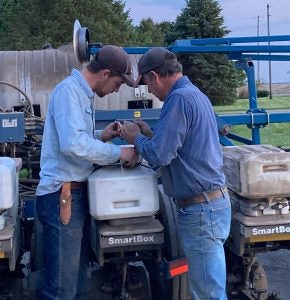Working in the agriculture industry sometimes means becoming creative with supplementing your income to make the day-to-day expenses for the farm work out. There are a lot of different ways to approach supplementing your income, from the more traditional methods of working somewhere local to making money from online sources. The only obstacle to how much you can make off the farm is your time, effort, and imagination.
Olivia Schoentrup and her husband, Paul, own a farm-to-table operation in Indiana where they raise beef, pork, and chicken on pasture and sell cuts directly to consumers. They finish all of their animals on just a six-acre property, with four of those acres being pasture.
“Last year, we finished 12 beef, 16 hogs and 1,300 meat chickens,” Schoentrup said. “We also have 25 to 30 laying hens and are experimenting with other pasture-type chickens.”

Paul Schoentrup works as a firefighter and paramedic, and the couple has been farming for six years. The farm pays for itself, but doesn’t really net a profit, so the Schoentrups started looking for extra ways to make money.
Creating a space on social media
“We have a YouTube channel [called Breaking New Roots], and showcasing our farm is making money,” Olivia Schoentrup said. “Our previous channel got deleted, and due to technical glitches, it was unrecoverable, so we had to restart from scratch in January 2022.”
The new YouTube channel is already monetized and bringing in a small income, which for every YouTuber is going to be different based on the size of their audience, a video’s reach, and the advertising structures in place. Schoentrup said that YouTube has specific parameters that video content must meet, and that new content should be consistently added.
“YouTube pushes the content out, and over time, as more people watch, bigger companies have their ads with your content,” she said. “We post in a storyteller category for farming, not a daily vlog.”
Schoentrup posts weekly, and she’s had to learn the best way to structure content in the editing process to keep viewers watching. Less than 10 hours a week are devoted to recording and editing the videos they upload.
“It’s definitely been a learning experience, but it’s been great sharing our story to show people, especially those who aren’t in farming, how their food is produced,” she said. “People are responding to that, but it’s not a get-rich-quick scheme.”

The YouTube algorithm changes quickly, based on viewership and viewers’ search and viewing histories, which is something content creators can’t anticipate.
“You can’t just look at the demographics and go find viewers,” she says.
The Schoentrups are hoping to make $100 a month on their YouTube channel by the end of 2022, but their long-term goal is to eventually be able to replace Paul’s income.
Another income stream for the Schoentrups is making soaps and lotions from the fat produced by their Mangalitsa pigs and candles from the beef tallow produced from their beef cattle.
“We try to be as efficient as possible to add value,” she says.
More traditional income streams work, too
Many farming couples have wives that are teachers or otherwise work off the farm to bring in the income and provide health insurance for the family. Lisa and Matthew Ellis, who live on the Illinois/Indiana state line between Springfield, Illinois, and Indianapolis, are one such couple. Their son, Chris, recently joined the farming operation, and his fiancée, Halea, is a music teacher at the local school.
“I have a teaching degree as well, but I haven’t used it traditionally,” Lisa Ellis said. “I’ve always worked, and even went back and got my MBA so I could bloom where I was planted.”

Ellis just recently started working remotely from their farm, where the Ellises raise 400 to 500 polled Herefords for seedstock. The operation is one of the top Hereford producers in the U.S. for carcass quality. In addition, the Ellis family farms 1,800 acres of corn, soybeans, and hay.
“I use my breaks to water the heifers, let the chickens out, get the mail, start lunch, take lunch to the field — it’s worked out wonderfully,” she said. “I see a lot of women doing non-traditional things to make money, and if it works, that’s great.”
Ellis notes that, before getting her MBA, she had no business background but knew that if she wanted to have more control and options in her career, she needed another degree. Although the farmwork is never-ending, she advises young farmers to be sure to always put family first.
“Another farmer also told my husband to make sure you get to your kids’ ball games and concerts, because your time with them is so short,” she said.
Building those family relationships and getting the kids involved in the farm are ways to help the next generation gain a sense of ownership in the farming operation, raising the likelihood that they’ll want to come back.
“I see so few kids involved in the farm, who haven’t had that love of the land and livestock and sense of community instilled in them,” Ellis said. “When the time comes, they’ll sell their inheritance because they don’t feel a tie, and it’s sad. I know it’s not easy to take your kids out on the farm as a parent, and there may be concerns about how to do so safely, but you’ve got to figure it out.”

What can you do?
The best way to supplement your farm income is to think about ways you can add value to what you’re already doing. What resources do you have at your disposal, and how can they be monetized? What talents, hobbies or skills do you have that could bring in additional income?
Here are some examples of how you can add value or monetize what you’re already doing:
- Renting out empty barn space to store campers or boats over the winter
- Butchering poultry
- Selling eggs or other products directly to consumers or have a booth at a local event
- Got a sunflower field or other idyllic spot on your farm? Reach out to photographers to offer it as a location for private photo shoots — for a nominal fee
- Selling excess garden produce
- Devote a couple of acres to a pumpkin patch and make it agri-tourism destination
Hopefully, these possibilities get some of your creative juices flowing. The sky is the limit!
Sarah Hill is an agricultural writer and communications professional from Hetland, South Dakota. She grew up on a dairy in Missouri and is a 2008 graduate of the University of Missouri with a degree in Agricultural Journalism.



